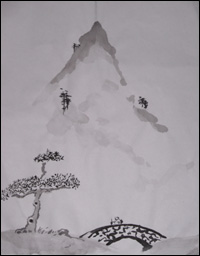Sumi-E
Sumi-e is an Asian style of brush painting that has a tradition stretching back over a thousand years. It is an art form that strives to capture the spirit or essence of an object or scene in the fewest possible brush strokes. Sumi-e is a contemplative art form. The same brush strokes are repeatedly practiced until they become the natural movements of the painter.
The tools of the sumi-e painter are the “Four Treasures”: an ink stone, an ink stick, a brush and paper. The ink stone, which features a shallow depression, serves to prepare and contain the ink. The ink stick is composed of soot and resin and is molded into a decorative stick which is a work of art in itself. The preparation of ink, which takes place immediately prior to painting, is a form of moving meditation that helps the painter to prepare for the painting process. Brushes used for sumi-e are generally made from animal hair and bamboo. An important feature of a sumi-e brush is its ability to hold a very fine tip. A painter must be able to use one brush to create both wide and thin lines. Rice paper is most commonly used for Sumi-e painting due to its ability to absorb, yet not be overly absorbent.
Four paint strokes, called the “Four Gentlemen”, are the bamboo, the orchid, the plum tree and the chrysanthemum. These four strokes are the basis for most sumi-e painting.
The sumi-e painter often applies a red seal to the work to signify the artist or a message of the artist.
Jack Stewart is a practitioner of sumi-e both as meditation and art.

